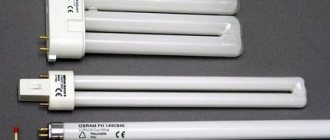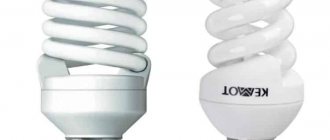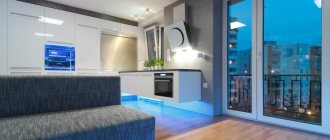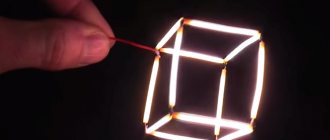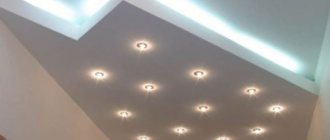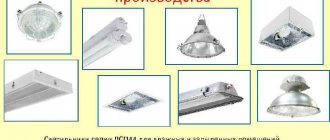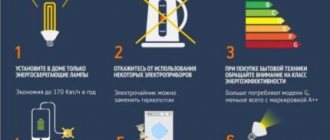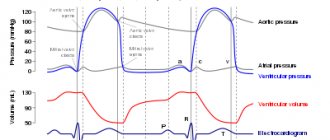In the 21st century, fluorescent lighting devices have become the main type of lamps for lighting. Among the considerable variety, these lighting sources are more common than others. Given their low energy consumption, these lighting devices provided sufficient illumination for large rooms, classrooms, high and long corridors, etc.
As a result, the development of gas-discharge lamp technology did not stand still, the lighting features of LDS were improved each time, smaller fluorescent lamps with brighter glow began to appear, and the quality of the light produced improved. Around the beginning of the “zero” years, the fluorescent lamp began to appear not only for industrial needs, but also at home. So the “Ilyich light bulb” was replaced by gas-discharge lighting devices. At the same time, more economical fluorescent lamps gave people a choice of lighting, from cool to warm shades of white and yellow.
Features of the device and design
The lamp contains an inert gas environment with mercury vapor. The inner surface is coated with phosphor, which is a luminescent substance. At the edges of the lamp there are tungsten spirals treated with barium oxide. The cathodes are connected to pins that provide connection to an external power supply.
For the lamp to work properly, it must be completely sealed. If oxygen penetrates into it, the chemical composition of the device will change and the lamp will lose its functionality.
The figure below shows the structure of a fluorescent lamp.
The following figure shows how a compact fluorescent lighting fixture is constructed.
Fluorescent light bulbs can only provide daylight. However, such lighting is quite bright, and therefore blinds the eyes. To make the light more comfortable, lamps are equipped with diffusers and reflectors. These devices help distribute light evenly throughout the room.
Phosphors and spectrum of emitted light
The composition of the phosphor applied to the inner layer of the glass bulb affects the color spectrum. Thus, the inexpensive halophosphate species projects mainly yellow and blue spectrum with minimal amounts of red and green. As a result, despite the high light output, when reflected, a distortion of the color shade is observed.
Lamps with increased light output contain a 3-band and 5-band phosphor, which significantly improves the photometric properties of the device. The lighting becomes more uniform and of higher quality, without the presence of distortion.
Areas of application
Based on the place of application, fluorescent light bulbs are usually divided into two types - industrial and household.
Industrial
They are used to organize lighting in enterprises. The lamps built into the spotlights are capable of illuminating large areas with high ceilings. For hazardous operating conditions (we are talking about enterprises in the chemical and alcohol industries), explosion-proof lamps are produced.
Household
To illuminate a residential building, as well as for offices, household modifications of fluorescent light bulbs are used. Fluorescent lamps are often used to illuminate offices, kitchens and corridors. There are special lamps designed for use in adverse conditions: they cope well with exposure to moisture and dust.
Types of structures
Based on design features, it is customary to distinguish the following types of lamps:
- Open ceiling products. To ensure safety, such lamps are sometimes equipped with protective grilles.
- Recessed lamps. Such light sources are mounted under the ceiling covering.
- Wall models. There are many modifications of such lamps. For example, the linear type of lamps has an elongated shape and is used to illuminate extended objects. Overhead models are installed using anchors fixed in the wall.
- Corner lamps. Such devices are mounted at the joints between the ceiling and walls. Externally, the design resembles a ceiling plinth. This type of lighting fixture is often chosen for kitchens.
- Hanging devices. Fixed to the ceiling structure using a cable. One wire carries from one to several light bulbs.
- Closed lamps. Used in combination with stretch ceilings. Such models do not overheat, which ensures the safety of the ceiling material.
- Furniture models. Fluorescent lamps are used to illuminate furniture. Fluorescent lighting not only performs a utilitarian function, but also serves as a decoration for furniture.
In recent years, the production of economical models of fluorescent lamps has been gaining momentum. The technology is based on the use of a special gas - phosphor. As a result of the interaction of gas and current, an ultraviolet glow is formed without heating the device.
Advantages and disadvantages
The advantages of fluorescent light sources include the following characteristics:
- High brightness of light, which allows for excellent visibility. Fluorescent lighting is especially useful when performing small manipulations that require precise movements.
- Long service life. Compared to incandescent lamps, fluorescent lamps last longer.
- Various modifications of lamps. Products are produced that are suitable for any interior.
- The bulbs do not overheat, which has a beneficial effect not only on the service life of the light source, but also on the finishing materials located in the immediate vicinity (we are talking primarily about stretch ceilings).
- Saving energy consumption.
- Easy to clean the device from dirt or dust.
The disadvantages of fluorescent lamps include:
- Lack of DC power supply.
- Sensitivity to temperature conditions, which can reduce the light output of the device.
- Presence of mercury inside the lamp, which creates a dangerous situation if the bulb is broken.
Important characteristics when choosing a lamp
When buying a lamp, you should take into account its technical capabilities:
- A significant advantage of the product is the possibility of a cold start. In such lamps, the electrodes heat up gradually, as a result of which the light turns on with a slight delay. A soft start significantly increases the working life of the lamp.
- It is recommended to take a closer look at the power ratio between the old incandescent lamp and the installed fluorescent lamp. The power of a fluorescent lamp of 12–15 W is enough to replace a 60-watt incandescent light bulb. However, despite the difference in power, the luminous flux characteristics of different types of lamps should be approximately the same.
- The color of the lamp is determined by the characteristics of the room. For an office or kitchen, cold light is preferable. This will increase your concentration on doing any work. In the bedroom, living room or dining room, warm color tones are more relevant. They do not irritate the organs of vision. For the bathroom or garage, you should choose devices that are protected from moisture and dust.
Basic parameters of lamps
Fluorescent lamps are characterized by the following main parameters.
Light parameters: 1) color and spectral composition of radiation; 2) luminous flux; 3) brightness; 4) pulsation of the light flux.
Electrical parameters: 1) power; 2) operating voltage; 3) type of supply current; 4) type of discharge and used luminous area.
Operational parameters: 1) light output; 2) service life; 3) dependence of light and electrical parameters on supply voltage and environmental conditions; 4) dimensions and shape of lamps.
The main feature that distinguishes lamps for mass use for lighting from the entire variety of fluorescent lamps is their combustion voltage, which is associated with the type of discharge used. Based on this feature, lamps are divided into three main types.
1. Arc discharge fluorescent lamps with a combustion voltage of up to 220 V. These lamps are most widespread in our country and European countries. Such lamps have a self-heating oxide cathode and ignite when it is preheated, which determines the main features of their design.
2. Arc discharge fluorescent lamps with a combustion voltage of up to 750 V. Such lamps (Slim line type) have become widespread in the USA, they operate without preheating the cathodes, and have a power of more than 60 W.
3. Glow discharge fluorescent lamps with cold cathodes. This type of lamp is used for advertising and signal lighting. They operate at low currents (from 20 to 200 mA) in high voltage installations (up to several kilovolts). Due to the small diameter of the tubes used, they can easily be molded into any shape.
A special group includes high-intensity lamps of increased power, having the dimensions of lamps of the first group. In such lamps it turned out to be necessary to use special methods of maintaining the pressure of saturated mercury vapor.
Let's consider the main parameters of fluorescent lamps of the first group. Of the parameters listed above that characterize fluorescent lamps, we have already considered the color and spectral composition of the radiation, luminous flux, power, type of discharge and the luminous area used. The values of other parameters of fluorescent lamps are given in Table 1. The average service life of lamps of all types with power from 15 to 80 W currently exceeds 12,000 hours with a minimum burning time of each lamp of 4,800 - 6,000 hours. During the average service life, the standard allows for a decline in luminous flux of no more than 40% of the initial one, and for a time equal to 70% of the average service life - no more than 30%.
Table 1
Characteristics of general purpose fluorescent lamps according to GOST 6825-74
| Types of lamps | Power, W | Current, A | Operating voltage, V | Dimensions, mm | Luminous flux, lm | Service life, h | |||
| Length with pins | Diameter | average | after minimum burning time | average | minimum | ||||
| LB15 LTB15 LHB15 LD15 LDTs15 | 15 | 0,33 | 54 | 451,6 | 27 | 820 820 800 700 600 | 600 540 525 450 410 | 15000 | 6000 |
| LB20 LTB20 LHB20 LD20 LDTs20 | 20 | 0,37 | 57 | 604 | 40 | 1200 1100 1020 1000 850 | 940 760 735 730 630 | 12000 | 4800 |
| LB30 LTB30 LHB30 LD30 LDC30 | 30 | 0,36 | 104 | 908,8 | 27 | 2180 2022 1940 1800 1500 | 1680 1455 1395 1180 1080 | 15000 | 6000 |
| LB40 LTB40 LHB40 LD40 LDTs40 | 40 | 0,43 | 103 | 1213,6 | 40 | 3200 3100 3000 2500 2200 | 2490 2250 2250 1900 1630 | 12000 | 4800 |
| LB65 LTB65 LHB65 LD65 LDTs65 | 65 | 0,67 | 110 | 1514,2 | 40 | 4800 4650 4400 4000 3160 | 3720 3310 3165 2705 2500 | 13000 | 5200 |
| LB80 LTB80 LHB80 LD80 LDTs80 | 80 | 0,865 | 102 | 1514,2 | 40 | 5400 5200 5040 4300 4800 | 4170 3745 3650 3100 2890 | 12000 | 4800 |
The brightness of fluorescent lamps of various colors and power ranges from 4 × 10³ to 8 × 10³ cd/m². The brightness of a lamp is related to its luminous flux Fl and geometric dimensions ratio
where L0 is the diameter-average brightness of the middle part of the lamp in the direction perpendicular to the axis, cd/m2; FL – luminous flux, lm; k is a coefficient that takes into account the decrease in brightness towards the ends of the tube, k = 0.92 for all lamps, with the exception of 15 W lamps, for which k = 0.87; d – inner diameter of the tube, m; lsv – length of the luminous part of the tube, m.
The unevenness of brightness along the diameter of the tube is associated with a change in the reflectance of the glass, which increases with increasing angle of incidence. It should be noted that all the indicated electrical and light parameters of fluorescent lamps are determined when the lamp is turned on with an exemplary measuring choke (DOI) at a rated stabilized voltage.
The luminous intensity of fluorescent lamps Iv in the direction perpendicular to their axis is related to the luminous flux by the relation
Iv = 0.108 × Fl.
The spatial distribution of luminous intensity of fluorescent lamps in the longitudinal plane is close to diffuse.
When fluorescent lamps are switched on to an alternating current network, in each half-cycle the discharge in the lamp goes out and re-ignites, which leads to a pulsation of the light flux. Due to the afterglow of the phosphor, the pulsation of the lamp's light flux is weakened compared to the pulsation of the discharge. The stroboscopic effect created by the pulsating light flux of fluorescent lamps is reduced by appropriately connecting groups of simultaneously switched fluorescent lamps to the power supply network, for example, on two or three opposite phases of the supply network.
| Figure 10. Dependence of the luminous flux of fluorescent lamps on the ambient temperature: 1 – with still air; 2 – at an air speed of 1 m/s; 3 – with a “thermal jacket” |
The electrical and light parameters of fluorescent lamps are determined by the parameters of the switching circuit and the network voltage. When the network voltage changes, the electrical parameters of the lamps and those of the light and operational parameters that are directly related to the electrical parameters also change. For any switching scheme, the parameters of fluorescent lamps depend significantly less on the supply voltage than the parameters of incandescent lamps.
The dependence of the parameters of fluorescent lamps on the pressure of saturated mercury vapor determines their sensitivity to changes in ambient temperature and cooling conditions. Figure 10 shows the dependence of the luminous flux on the ambient temperature. As is known, air, depending on the speed of its movement, significantly changes its cooling effect. Therefore, the dependence of the luminous efficiency of lamps, as can be seen from Figure 10, is determined not only by temperature, but also by the speed of air movement.
Areas of application
Fluorescent light sources are used in many areas of human activity:
- In medicine. Fluorescent lamps are often used in medical offices. The quality of light allows doctors to carry out diagnostic measures more thoroughly.
- Luminescent devices are common in manufacturing. Features of the technology make it possible to cover large areas with high-quality concentrated lighting. Daylight is especially important when carrying out small precision operations (for example, when working on a lathe).
- In the kitchens of public catering establishments, as well as for cooking at home.
- In scientific institutions and laboratories.
- In libraries, in educational institutions.
- For organizing outdoor lighting. Fluorescent sources are used not only for lighting, but also as decorative light. Fluorescent lamps are often found on garage canopies and at building entrances.
- Office rooms.
- Trading establishments.
- Living spaces.
Interior use
Fluorescent light sources are used in a wide variety of interior solutions, but they are most appropriate in modern styles:
- High tech. This style uses long lamps mounted at the junctions of ceilings and walls. Such lamps emphasize the geometry of the room. For high-tech, cold tones are most often used.
- Minimalism. Fluorescent lamps are made of plastic and are massive flat structures.
- Ecological design. They are used in a frame of natural materials (wood or leather) and emit warm light.
- Premises in loft style. Such lamps in their design and placement must correspond to the general style of the room - a former industrial building converted into apartments.
- Eclecticism. Economy lamps placed in a line are used.
Note! Cold light is suitable for living spaces with windows facing south. Also, cold light dilutes the too warm tones of finishing materials.
Installation of fluorescent lamps
If desired, it is easy to install fluorescent lamps yourself. Installation of lighting devices is carried out based on their design features. The devices are mounted on ceiling structures, on walls, in columns, etc. For fixation, dowels and mortgages are used.
Ceiling sockets are installed to connect the luminaire wiring to the electrical network. They mask the hole from which the conductors come out.
For wall lamps, sockets are mounted at a short distance from the light source. A cord comes out of the housing and connects to the power source through a plug.
When installing a mechanical switch, special attention should be paid to the reliability of the contacts. Otherwise, during operation, the contact surfaces may shift, causing the lamp to stop working.
The connection diagram of the device is also important. Most often on the market there are modifications equipped with chokes and starters. Such devices have dedicated sockets. One of the capacitors is connected in parallel and acts as a voltage stabilizer. The second capacitor is designed to extend the pulse time at the start. This connection is called electromagnetic balance. Its diagram is shown in the figure below.
All fluorescent lamps have a diagram. It is shown on the back of the device. The diagram contains sufficient information about the number of light bulbs, their power, as well as other significant characteristics of the device.
Note! It is easy to convert a lamp with fluorescent lamps to work with LEDs. Before replacing the lamp, the ballast must be removed from the circuit. Light diodes must receive voltage directly.
The optimal way to place fluorescent devices is to hang them on the main line (lighting boxes like KL-1 or KL-2). Together with the boxes, all the necessary components for installing a fluorescent lamp are available for sale.
Important! Before connecting the lamp, you should insulate the ends of the wires.
Types of lamps and base
As a rule, in their apartments and private houses, people use compact gas-discharge lighting devices that are screwed into a common base; these lamps are powered by a 220 W network. This also occurs in the use of small four-pin light devices that are commonly found in luminaires. With rare exceptions, these light sources have an arc-shaped appearance. Unlike base lamps, such lamps require a “relay” starting device, so their main use is in industrial or administrative premises.
Lamp sockets.
A necessary part in the design of any lighting device is the base. The base, no matter what type of lamp it is in, ensures, through a special connection, contact of the fluorescent lamps with the electrical circuit. So, sockets for lighting devices can be of the following types:
- Threaded (screw). Threaded pedestals have a simple and comfortable design that allows you to screw in the flask as quickly as possible. Electric lamps are very diverse in terms of bulb design, but the most common are electric lamps with a base of type e14 and e27.
- Bayonet. At first it was intended for tubular-type gas-discharge lamps. Later they also began to use it for installing halogen and LED structures. It is made in the form of pins. The pedestals of pin-type lamps differ in the number of pins and the distance between them. So, for example, if the lamp base is g13, then this indicates that the distance between its pins will be 13 millimeters. The disadvantages of such a pedestal include the difficulty in determining its size by eye.
- With recessed contact. Used in tubular quartz and halogen lamps with increased heating temperature and power. The number in its marking indicates the length of the metal element.
- Soffitny. Previously used only for stage lighting. Its contacts can be located either on one side of the lamp or on both sides at once.
- Pin. Along the outer diameter there are two pins connecting the pedestal itself and the cartridge. With such a simple design, the lamp can be connected to the network without much difficulty.
- Focusing option. It is a lens design that helps focus the light flux.
- Telephone option. It requires a small light bulb.
Possible breakdowns
There are several common reasons why fluorescent devices malfunction:
- Triggering of the protective mechanism. This happens due to a short circuit in the electrical network (behind the machine) or a malfunction of the capacitor at the input. This problem is especially common when replacing fluorescent lamps with LED lamps. The problem is corrected by replacing the capacitor. The contacts of the cartridges and the starter should also be tested for working condition. Light bulbs may need to be replaced.
- The light doesn't turn on. The reason is insufficient voltage in the cartridge or its complete absence. The voltage is checked using an indicator screwdriver or a multitester. If the device does not turn on, but there is light at the ends of the tube, the starter is broken. In this case, the starter should be replaced. The absence of a glow indicates a malfunction of the throttle, starter or the lamp itself. If only one end lights up, there is an error in the circuit and needs to be double-checked.
- Continuous flickering. The problem occurs when the starter fails or when there is insufficient voltage in the electrical network. You also need to check the connection diagram - there is probably an error.
- Regular turning on and off of the light bulb indicates its failure. The lamp will need to be replaced.
Checking the lamp
First, check the proper operation of the lamp using a multimeter or tester. There are certain nuances in four-lamp and two-lamp lamps. For example, in an Armstrong lamp, electronic ballasts for 4 lamps, if one bulb fails, all four will not light. The same applies to devices with one starter for two tubes. In luminaires where each lamp has a dedicated starter, the luminaire will function without problems if other lamps fail.
If the power supply is connected, but the lamp does not turn on, check the voltage supply. This is done from the terminal block at the input.
The performance of fluorescent light sources is assessed by the integrity of their components that ensure current transport:
- The throttle should not make any sounds.
- The starter is checked by connecting it to an incandescent light bulb and a socket.
- Check the capacitance of the capacitor.
Diagnostics are carried out only with the device disconnected from the power supply. The optimal means for taking measurements is a multimeter or ohmmeter. To carry out the test, remove the starter from the cartridge and connect the contacts. The probes are brought to the terminals of the lamp wires. As a result, the device will display the total resistance of the lamp.
Bulb replacement option
If the lamp burns out, you should definitely replace it in the following way:
- Disassemble the lamp. It is important to do this as carefully and accurately as possible in order to avoid mechanical damage to the structure. Next, you should turn the tube along the axis in the direction indicated on the holder.
- If the tube is in a perpendicular position, it should be lowered downwards. In this case, the contacts must exit through the holes in each holder.
- The contacts of the new lighting device must be positioned vertically, falling into their hole. After installing the light bulb, turn the tube in the opposite direction. Then, to check that the lamp is working properly and that it is connected correctly, turn on the power.
- At the end, it is worth installing a lampshade that has a diffusion function.
In general, this is all I would like to say about this lighting option and how to properly work with it. You should definitely look at the photos of fluorescent lamps that are attached below.
This will help you better understand the information received on this topic. It is imperative to choose the right lighting source, because, as was said at the very beginning of the article, this lamp plays a vital role in people’s lives and is available to almost every person in the post-Soviet space, and the whole world as a whole!
Famous manufacturers
In order for a fluorescent lamp to work for a long time, it is recommended to study the proposals of manufacturing companies in advance. There are products from dozens of companies on the market. However, only a few brands have achieved an impeccable reputation:
- Philips. The products of the Dutch company are the standard of quality and technological excellence. The Philips assortment includes a wide variety of modifications of fluorescent lamps.
- Ares. The products of the Italian company are known all over the world. The company produces lamps not only for indoor lighting, but also for decorative lighting.
- "Thorn Lighting" (Austria). The company has established itself as a manufacturer of high-quality equipment for industrial and warehouse facilities. Also in the Thorn Lighting assortment there are fluorescent spotlights.
- Osram. The German manufacturer is one of the leaders in the global lighting equipment market.
Products from domestic companies are also on sale:
- offers economical lamps for residential and office premises, as well as for outdoor lighting. The products are equipped with moisture-proof and dust-proof fuses.
- "New World". One of the leaders in the production of powerful fluorescent lamps, as well as floodlight equipment.
- JazzWay. The company produces a wide range of various lighting equipment, including fluorescent and LED devices.
- "Xenon". This manufacturer specializes in lamps for industrial premises and large office facilities.
- "Aten". Manufactures products for outdoor lighting.
- "Leader Light". Manufacturer with a large line of lighting equipment. The range includes products for road lighting.
In general, products from Western manufacturers are considered to be of the highest quality. However, Russian companies offer fluorescent lamps at more affordable prices.
Options for fluorescent sources
There are a huge number of lamps on the market. However, the types of fluorescent lamps are:
- Standard ones, in which the phosphor coating is coated in a single layer
- Improved, in them spraying consists of three or even five applications
- Specialized, needed for specific purposes and contain special additives. Lamps are used for self-tanning, protecting yourself and loved ones from bacterial organisms, and also for business shows.

